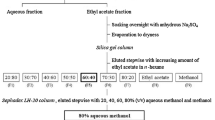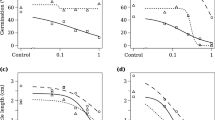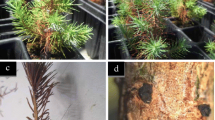Abstract
The root exudates fromPolygonum sachalinense in a recirculating system significantly inhibited lettuce seedling growth. The rhizomes and roots ofP. sachalinense were extracted with 80% acetone. Bioassay of the neutral-acidic fraction on the TLC agar plate showed the inhibitory activity corresponded to the two yellow pigment bands. Two orange needles were isolated and identified as anthraquinone compounds: emodin and physcion. Both compounds exhibited inhibitory activities against the seedling growth of several testing plant species. Glucosides were isolated fromP. sachalinense and were identified as emodin-1-O-β-D-glucoside and physcion-1-O-β-D-glucoside, respectively. On plant growth bioassay, these glucosides showed no phytotoxic activity against lettuce seedlings. The concentrations of emodin, physcion, and their glucosides from rhizome with roots, aerial parts, fallen leaves, and soil were determined. The rhizome with roots and fallen leaves contained emodin and physcion at relatively high concentrations. Emodin also occurs in the soil of this plant community with effective concentrations in the fall. The results indicate that these anthraquinones are responsible for the observed interference and are potent allelopathic substances.
Similar content being viewed by others
References
Al Saadawi, I.S., andRice, E.L. 1982a. Allelopathic effects ofPolygonum aviculare L. I. Vegetational patterning.J. Chem. Ecol. 8: 993–1009.
Al Saadawi, I.S., andRice, E.L. 1982b. Allelopathic effects ofPolygonum aviculare L. II. Isolation, characterization, and biological activities of phytotoxin.J. Chem. Ecol. 8:1011–1023.
Al Saadawi, I.S., Rice, E.L., andKarns, T.K.B. 1983. Allelopathic effects ofPolygonum aviculare L. III. Isolation, characterization, and biological activities of phytotoxin other than phenol.J. Chem. Ecol. 9:761–114.
Anke, H., Kolthoum, I., andLaatsch, H. 1980. Metabolic products of microorganisms. 192. The anthraquinones of theAspergillus glaucus group. II. Biological activity.Arch. Microbiol. 126:231–236.
Harborne, J.B. 1988. Introduction to Ecological Biochemistry. Academic Press, New York.
Kang, S.S., andWoo, W.S. 1982. Anthraquinones from the leaves ofPolygonum sachalinense. Kor.J. Pharmacol. 13:7–9.
Kato, T., andMorita, Y. 1987. Anthraquinone components inRumex acetosa L.Syoyakugaku Zasshi 41:67–74.
Kitanaka, S., andTakido, M. 1986. Studies on the constituents in the roots ofCassia oflusifolia L. and the antimicrobial activities of constituents of the roots and the seed.Yakugaku Zasshi 106:302–306.
Podojil, M., Sedmera, P., Vokoun, J., Betina, V., Baráthová, H., Duracková, Z., Horáková, K., Nemec, P. 1978.Eurotium (Aspergillus)repens metabolites and their biological activity.Folia Microbiol. 23:438–443.
Rice, E.L. 1964. Inhibition of nitrogen-fixing and nitrifying bacteria by seed plant.Ecology 45:824–837.
Rice, E.L. 1984. Allelopathy, 2nd ed. Academic Press, New York.
Rovira, A.D. 1969. Plant root exudates.Bot. Rev. 35:35–59.
Stevens, G.A., {jrJr.}, andTang, C.S. 1985. Inhibition of seedling growth of crop species by recirculation root exudates ofBidens pilosa L.J. Chem. Ecol. 11:1411–1425.
Tadano, T., andTanaka, A. 1976. Differences for crop species of ammonium and nitrogen suitability.Nippon Dojo-Hiryogaku Zassi 47:321–328.
Tukey, H.B. 1969. Implications of allelopathy in agricultural plant science.Bot. Rev. 35:1–16.
Author information
Authors and Affiliations
Rights and permissions
About this article
Cite this article
Inoue, M., Nishimura, H., Li, H.H. et al. Allelochemicals fromPolygonum sachalinense Fr. Schm. (Polygonaceae). J Chem Ecol 18, 1833–1840 (1992). https://doi.org/10.1007/BF02751107
Received:
Accepted:
Issue Date:
DOI: https://doi.org/10.1007/BF02751107




